This post may contain affiliate links which won’t change your price but will share some commission.
Hey hey. Happy Thursday!
I’m sharing a super cute and easy little spring craft over at Remodelaholic today. Amidst all of the more home renovation stuff we’ve been up to I find it fun to just sit at the table with a little glue and glitter every now and again and work on something that I don’t need to think “will the future home owner’s like this?”, “how will this effect resale?” or “how exactly am I going to repaint the entire exterior all by myself?”. You know, without making a mess of the entire sidewalk.
And in the last couple of weeks we had visits from my mom, mother-in-law, sister-in-law and niece (who turned 12 while she was here!) so there’s been quite a bit of non-house stuff going on, in addition to some just-for-plain-fun house stuff. You know … pillows and plantings and decorating a church pew stuff.
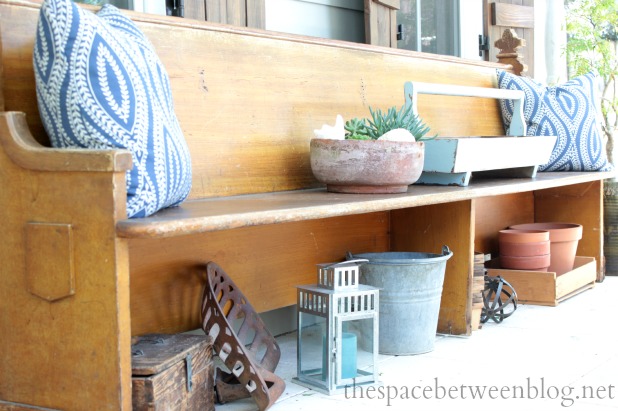
But, back along the home improvement front, we talked about the primer we used on the exterior here. And I was thrilled to get more “sometimes we’ve just gotta use some VOCs” comments than “I would never ever use VOCs, even if it was apparent it would be the best product for the job”. So thanks for that. Sometimes it just is what it is, if you know what I mean.
And with the use of the oil based primer and paint comes either the a) throw the brush away after every use or, b) figure out how to clean all of that nasty stuff off that dang brush solution.
And since good quality paint brushes are not exactly pocket change I opted to try my hand at option b. And it worked.
Like most new things, the process for figuring out how to clean my oil based paint brushes started with a little googling and I quickly found this tutorial from Kristi, but I didn’t have any mineral spirits on hand so I improvised and after a few minutes I had a nice and clean paint brush.
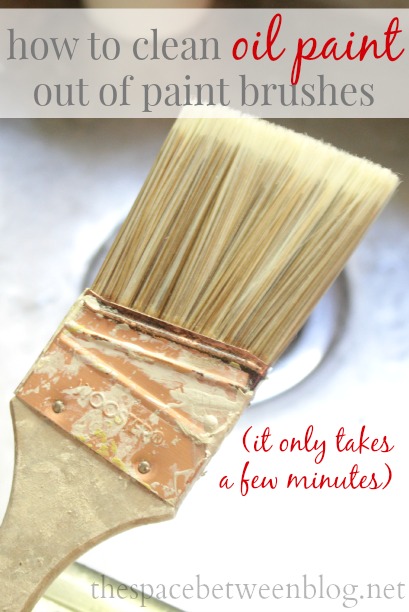
Here’s what worked for me.
All you need:
- oil based paint soaked brush
- rag
- disposable cup
- acetone (the active ingredient in fingernail polish remover)
- olive oil
- running tap water
- a little bit of patience
1 – Find some oil paint and dunk your brush in it.
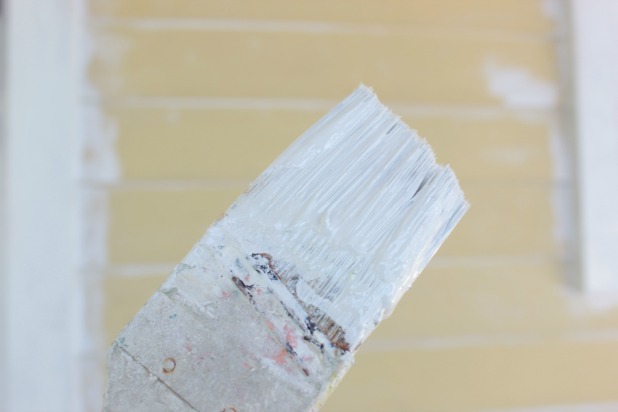
2 – Wipe as much excess paint out of the brush with a rag, or in my case a dish towel.
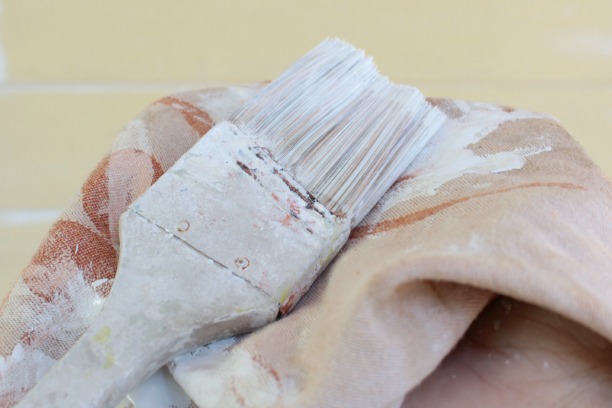
3 – Fill a cup with a cup or so of acetone, I happened to have a can of it on hand from that time I tried to cut a bottle with string. Acetone is inexpensive an easy to find in any home improvement store.
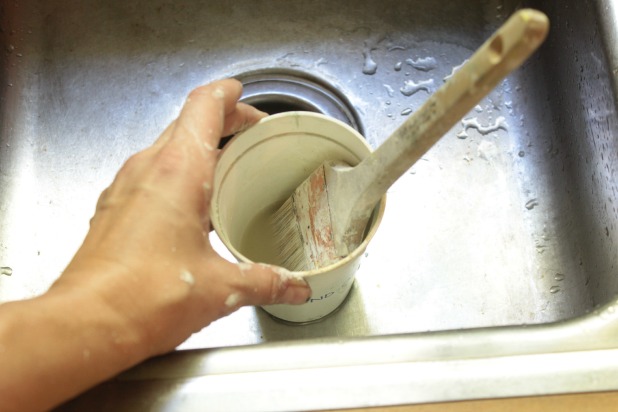
4 – Dunk the brush and swish it around. Much of the paint will magically fall off and accumulate in the bottom of the cup. It is seriously kind of amazing how thick this paint is and how much it clumps up at the bottom of the cup.
You could dispose of this acetone paint mixture and repeat if you feel like it would help. Depending on the brush I sometimes do this twice.
5 – Pour about a teaspoon of oil onto the brush. Keep the brush over the sink and warm tap water running so the paint doesn’t accumulate in your sink. I used olive oil, but I’m sure vegetable or another kind would work just fine.
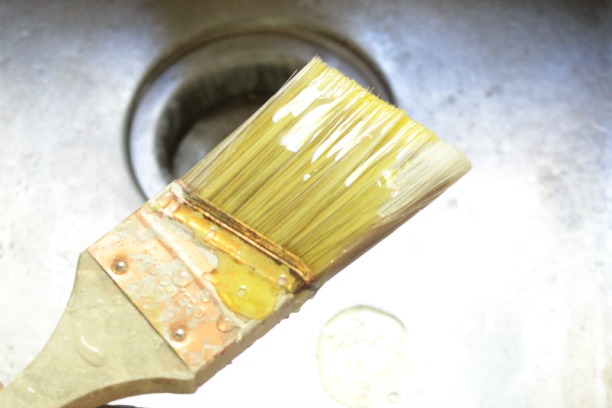
6 – Work it, work it, work it. Get your fingernails and tips right in there and literally work the paint out of the brush.
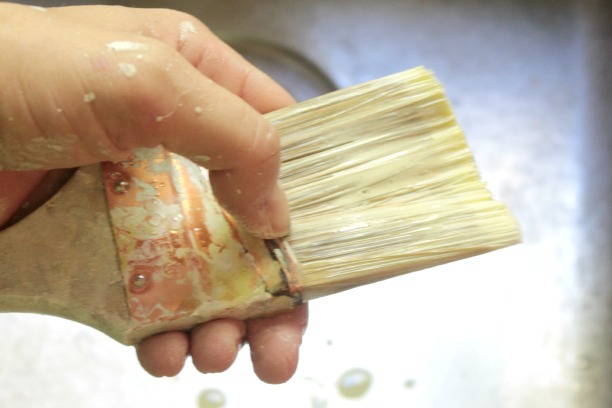
Run your fingers right up through the bristles and you will be a mess, and now that I’m looking at the picture, you should start out by taking off your rings, especially if they happen to be of the wedding variety. Oops.
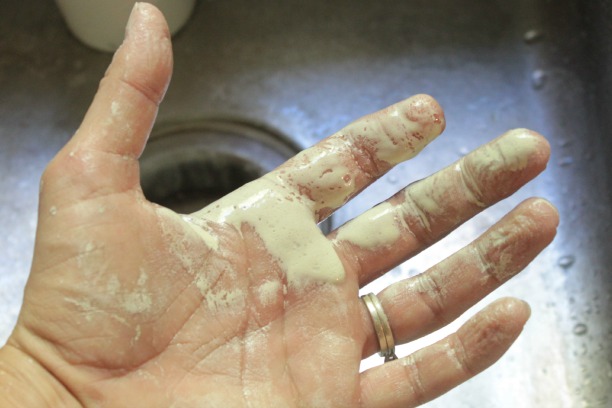
You’re going to need to repeat this step a few times, and don’t forget to keep the water running. But I was so happy that at the end of it all I had a perfectly usable brush.
I did put it in the fridge until the next time I used it, because that works whenever you don’t want to wash your brush at all between uses (we all know that by now, right?!?!) and I just wanted to be safe. But I’ve gone back to using the brush with regular old paint and have since washed it a few more times with just water and it is definitely good to go.
So, for a few dollars and a few minutes I saved one lone paint brush. That makes my cheap self a very happy cheap self.
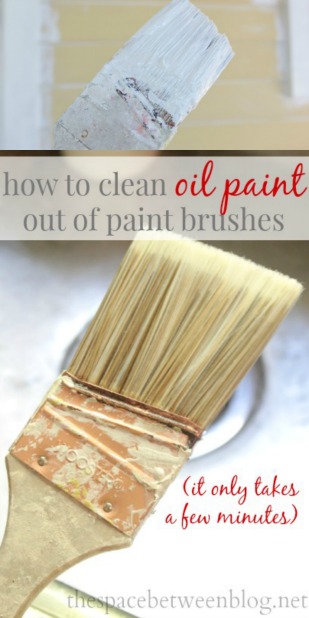
************************************





shirley@housepitalitydesigns says
Wow…that brush looks new!…Now, I wonder if polish remover can be substituted for acetone?…Hoping over to see your feature!
Karah says
I bet it could!
john livingstone says
great idea saves throwing away good brushes,some things not to easy to get in Scotland(.acetone ).
lynn cockrell says
Good tips, Karah. Good paint brushes are very expensive these days and so I try to reuse them every time. The oil is something I have not tried yet, but I certainly will now! Thanks!
Ashley@AttemptsAtDomestication says
Great tips! I’ve ruined oh so many paintbrushes over the years!
Lisa says
Ah! marveling at your greatness!! I usually buy my brushes at the ReStore and always look for ways to reduce waste. Great info – thanks much!
Karah says
Anything to reduce waste and save a few dollars.
Niki says
Sounds like a great substitute for mineral spirits. How did you dispose of the acetone? That’s my biggest dilemma when using mineral spirits, too!
Karah says
I probably should have but I didn’t do anything special for disposal.
Tom says
wow i’ve been looking for an inexpensive way to clean my paint brushes! glad i came across this. Thank you! i would probably just leave it out and let it evaporate and throw the residue or put in paper towels and throw in the trash!
Joan says
I don’t want to hurt anyone’s feelings, but it would probably be better for our drinking water supply not to put such things down the drain. I am a painter, and always wash my brushes in a pot, then toss that water in a corner of the yard. Only when the water is almost clear do I do a final rinse of water down the drain…just sayin’
Karah says
No hurt feeings here, Joan, and you probably right. I’ll make a note of it for next time to toss it in the corner of the yard. Thank you for the tip!
karen@somewhatquirky says
OK. Thanks for this. I always did the pour paint thinner into the cup, soak the brush, wipe the brush, pour paint thinner into the cup, soak the brush, wipe the brush, pour paint cleaner into the brush, soak the brush, wipe the brush, … you get the point. I never knew about washing with oil thing. I’m assuming you didn’t break any EPA standards by washing the acetone down the drain? I’m also assuming that this could be done with mineral spirits, paint thinner etc as the first step.
Karah says
Now I’m using oil for all kinds of random things … there is a great comment from a painter about dumping the acetone in the corner of the yard, I’ve been doing that since.
MM says
Rinsing it into the dirt is just as damaging as putting it in the drain. When you rinse it out and put it in your yard it runs off and all of those chemicals end up in streams, lakes, rivers and eventually the ocean. That’s why the storm drains have signs on them that say “No dumping, flows to ocean” or similar. The only safe way to manage waste chemicals would be to save them up in a can and then take them to a municipal household hazardous waste site.
Linda Stewart says
Helpful post! I am going to renovate my kitchen. I want to paint the walls in green by myself. Thanks a lot for the useful tips! Regards! Camberwell Carpet Cleaners Ltd.
paint tools says
I don’t think that you need to use chemicals. I use the Paint Piranha, only takes 5 minutes
Maryke says
Equal parts cloudy ammonia and turps gets dried paint out of clothes. I use this for paint brushes which can then be rinsed in hot soapy water.
Harry says
Awesome tip
I’ll be using your guide, thank you
Thomas Roberge says
Thanks for your useful tip . Kind regards
best pole saw lab says
Great tips, Karah. Great paint brushes are exceptionally costly nowadays thus I attempt to reuse them without fail. The oil is something I have not attempted yet, but rather I surely will now! Much obliged!
katherine says
Ouch! I’m going to be the bad guy here and be the one to tell you that EPA classifies acetone as a hazardous waste. It should never be put down the drain or into the soil because, not only is it highly flammable, it pollutes ground water! A little jar-ful to clean a few paint brushes doesn’t seem like a big deal, but there are lots of us painters out here, and the cumulative effect is significant. Just put it in an air-tight container and take it with other hazardous wastes to an appropriate hazardous waste location. Once I found out what a poison this stuff was, I just couldn’t dump it anymore.